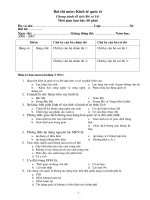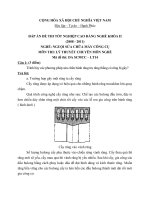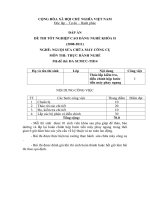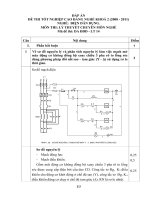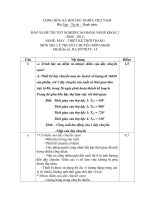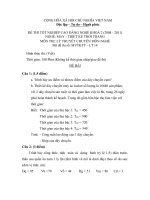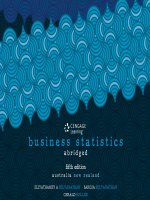- Trang chủ >>
- Đại cương >>
- Kinh tế vi mô
micro mankiw chap 14
Bạn đang xem bản rút gọn của tài liệu. Xem và tải ngay bản đầy đủ của tài liệu tại đây (405.65 KB, 47 trang )
Firms in Competitive
Markets
Copyright©2004 South-Western
14
WHAT IS A COMPETITIVE
MARKET?
• A perfectly competitive market has the
following characteristics:
• There are many buyers and sellers in the market.
• The goods offered by the various sellers are largely
the same.
• Firms can freely enter or exit the market.
Copyright © 2004 South-Western
WHAT IS A COMPETITIVE
MARKET?
• As a result of its characteristics, the perfectly
competitive market has the following
outcomes:
• The actions of any single buyer or seller in the
market have a negligible impact on the market
price.
• Each buyer and seller takes the market price as
given.
Copyright © 2004 South-Western
WHAT IS A COMPETITIVE
MARKET?
• A competitive market has many buyers and
sellers trading identical products so that each
buyer and seller is a price taker.
• Buyers and sellers must accept the price determined
by the market.
Copyright © 2004 South-Western
The Revenue of a Competitive Firm
• Total revenue for a firm is the selling price
times the quantity sold.
TR = (P × Q)
Copyright © 2004 South-Western
The Revenue of a Competitive Firm
• Total revenue is proportional to the amount of
output.
Copyright © 2004 South-Western
The Revenue of a Competitive Firm
• Average revenue tells us how much revenue a
firm receives for the typical unit sold.
• Average revenue is total revenue divided by the
quantity sold.
Copyright © 2004 South-Western
The Revenue of a Competitive Firm
• In perfect competition, average revenue equals
the price of the good.
T o ta l re v e n u e
A v e ra g e R e v e n u e =
Q u a n tity
P ric e × Q u a n tity
=
Q u a n tity
= P ric e
Copyright © 2004 South-Western
The Revenue of a Competitive Firm
• Marginal revenue is the change in total revenue
from an additional unit sold.
MR =∆TR/ ∆Q
Copyright © 2004 South-Western
The Revenue of a Competitive Firm
• For competitive firms, marginal revenue equals
the price of the good.
Copyright © 2004 South-Western
Table 1 Total, Average, and Marginal Revenue for a
Competitive Firm
Copyright©2004 South-Western
PROFIT MAXIMIZATION AND THE
COMPETITIVE FIRM’S SUPPLY CURVE
• The goal of a competitive firm is to maximize
profit.
• This means that the firm will want to produce
the quantity that maximizes the difference
between total revenue and total cost.
Copyright © 2004 South-Western
Table 2 Profit Maximization: A Numerical Example
Copyright©2004 South-Western
Figure 1 Profit Maximization for a Competitive Firm
Costs
and
Revenue
The firm maximizes
profit by producing
the quantity at which
marginal cost equals
marginal revenue.
MC
MC2
ATC
P = MR1 = MR2
AVC
P = AR = MR
MC1
0
Q1
QMAX
Q2
Quantity
Copyright © 2004 South-Western
PROFIT MAXIMIZATION AND THE
COMPETITIVE FIRM’S SUPPLY CURVE
• Profit maximization occurs at the quantity
where marginal revenue equals marginal cost.
Copyright © 2004 South-Western
PROFIT MAXIMIZATION AND THE
COMPETITIVE FIRM’S SUPPLY CURVE
•
•
•
When MR > MC ➪ increase Q
When MR < MC ➪ decrease Q
When MR = MC ➪ Profit is maximized.
Copyright © 2004 South-Western
Figure 2 Marginal Cost as the Competitive Firm’s Supply
Curve
Price
P2
This section of the
firm’s MC curve is
also the firm’s supply
curve.
MC
ATC
P1
AVC
0
Q1
Q2
Quantity
Copyright © 2004 South-Western
The Firm’s Short-Run Decision to Shut Down
• A shutdown refers to a short-run decision not to
produce anything during a specific period of
time because of current market conditions.
• Exit refers to a long-run decision to leave the
market.
Copyright © 2004 South-Western
The Firm’s Short-Run Decision to Shut Down
• The firm considers its sunk costs when deciding
to exit, but ignores them when deciding
whether to shut down.
• Sunk costs are costs that have already been
committed and cannot be recovered.
Copyright © 2004 South-Western
The Firm’s Short-Run Decision to Shut Down
• The firm shuts down if the revenue it gets from
producing is less than the variable cost of
production.
• Shut down if TR < VC
• Shut down if TR/Q < VC/Q
• Shut down if P < AVC
Copyright © 2004 South-Western
Figure 3 The Competitive Firm’s Short Run Supply Curve
Costs
If P > ATC, the firm
will continue to
produce at a profit.
Firm’s short-run
supply curve
MC
ATC
If P > AVC, firm will
continue to produce
in the short run.
AVC
Firm
shuts
down if
P< AVC
0
Quantity
Copyright © 2004 South-Western
The Firm’s Short-Run Decision to Shut Down
• The portion of the marginal-cost curve that lies
above average variable cost is the competitive
firm’s short-run supply curve.
Copyright © 2004 South-Western
The Firm’s Long-Run Decision to Exit or
Enter a Market
• In the long run, the firm exits if the revenue it
would get from producing is less than its total
cost.
• Exit if TR < TC
• Exit if TR/Q < TC/Q
• Exit if P < ATC
Copyright © 2004 South-Western
The Firm’s Long-Run Decision to Exit or
Enter a Market
• A firm will enter the industry if such an action
would be profitable.
• Enter if TR > TC
• Enter if TR/Q > TC/Q
• Enter if P > ATC
Copyright © 2004 South-Western
Figure 4 The Competitive Firm’s Long-Run Supply Curve
Costs
Firm’s long-run
supply curve
Firm
enters if
P > ATC
MC = long-run S
ATC
Firm
exits if
P < ATC
0
Quantity
Copyright © 2004 South-Western



